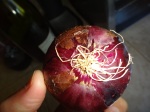(scene from Pride and Prejudice of dying ribbons with beets)
Pigments serve a variety of roles in plants. Many pigments have physiological roles within plants and protect plant tissues from sunburn and pathogens and herbivores (see review by Koes et al. 2005). Most noticeably, however, their brilliant colors attract animal pollinators to flowers and seed dispersers to fruit. Humans are also interested in plant pigments, in part because they color and sometimes flavor our food, are potentially medicinally active, and have been used as natural dyes and paints for millennia.
red cabbage
Last weekend I made some natural Easter egg dyes from turmeric and beets (I followed these instructions). We also considered making dyes from red and yellow onion skins or red cabbage, but we kept it simple. This handful of plants used to make cheap, easy, homemade dyes can give us some insight (“some” in this case being “a very small amount”) into of the chemical and evolutionary diversity of plant pigments.
To be honest, we made curry powder-colored eggs instead of just turmeric-colored eggs. We had a lot of old “sweet curry” spice mix, of which the primary ingredient is turmeric, and no turmeric by itself. This ended up being a boon because the hard-boiled eggs that we soaked overnight in the curry powder dye ended up tasting lightly curry-flavored (a good thing). The color, too, was gorgeous. The spice turmeric comes from the rhizome (underground stem) of Cucurma longa (family Zingiberaceae), native to tropical southeastern India. Much (if not all) of turmeric’s yellow-orange color (and its distinctive earthy flavor) comes from its curcuminoids, natural phenols. These are likely defensive compounds that help the plant thwart herbivores and pathogens.
color courtesy carotenes
Curcuminoids are not widespread among plants, unlike other yellowish pigments, most notably the hydrocarbon carotenoids (xanthophylls and carotenes, including vitamin A precursors). The yellow-orange color of the yolks inside our Easter eggs came from the xanthophylls lutein and zeaxanthin that the chickens obtained from their food, ultimately from plant sources. Xanthophylls provide sunscreen to leaves. Carotenes have photosynthetic roles, but they’re mostly known for the color they give to many plant structures. Most carotenes confer yellow or orange color, but the carotene lycopene is bright red and is a primary pigment of tomatoes, red carrots, watermelons, and papayas. Although carotenoids are common, I don’t know much about their use as a dye. If we had used yellow onion skins to dye the eggs, the yellow color would have come not from carotenoids but from oxidative byproducts of flavonoid pigments, notably quercetin.
Red onion color from anthocyanins and quercetin
Red cabbage and red onion get their purple color from anthocyanins, the most common purple and blue pigments found in nature. Beets, however, get their red and yellow colors from betalain pigments, which replace anthocyanins, and to some extent carotenoids, as a pigment source in most families in the botanical order Caryophyllales (see our Food Plant Tree of Life phylogeny page for details on phylogenetic placement of the Caryophyllales; and see this excellent article for the comparative biology of anthocyanins and betalains within the Caryophyllales). That may initially sound obscure, but there are a lot of food plants in the Caryophyllales, all with betalains instead of anthocyanins (See our Food Plant Tree of Life list).
Betalains turn salads with beets bright pink
I had high hopes for the beet dye, but the white of the egg turned a more impressive purple-pink color than did the shell for us. I’m not sure why but am willing to try it again. Next time, I’ll definitely try some anthocyanin-derived dye alongside the betalain dye. And I might have to use some yellow beets, too, to get some yellow betalain dye to compare to the quercetin (onion) and curcuminoid (turmeric) dyes. At some point in your primary education you may have done a chemistry lab (like this one) using red cabbage-derived anthocyanins to learn about pH, as the anthocyanins can display an impressive range of color depending on pH.
The acid (vinegar) in the dye may complicate this plan, but I wonder if there is a way to take advantage of the pH-sensitivity of anthocyanin pigments in dye making.
This is obviously hardly our last word about plant pigments. More later. Happy spring!
Link:





Nenhum comentário:
Postar um comentário